The AMD Ryzen Threadripper 1950X and 1920X Review: CPUs on Steroids
by Ian Cutress on August 10, 2017 9:00 AM ESTCPU Rendering Tests
Rendering tests are a long-time favorite of reviewers and benchmarkers, as the code used by rendering packages is usually highly optimized to squeeze every little bit of performance out. Sometimes rendering programs end up being heavily memory dependent as well - when you have that many threads flying about with a ton of data, having low latency memory can be key to everything. Here we take a few of the usual rendering packages under Windows 10, as well as a few new interesting benchmarks.
All of our benchmark results can also be found in our benchmark engine, Bench.
Corona 1.3: link
Corona is a standalone package designed to assist software like 3ds Max and Maya with photorealism via ray tracing. It's simple - shoot rays, get pixels. OK, it's more complicated than that, but the benchmark renders a fixed scene six times and offers results in terms of time and rays per second. The official benchmark tables list user submitted results in terms of time, however I feel rays per second is a better metric (in general, scores where higher is better seem to be easier to explain anyway). Corona likes to pile on the threads, so the results end up being very staggered based on thread count.
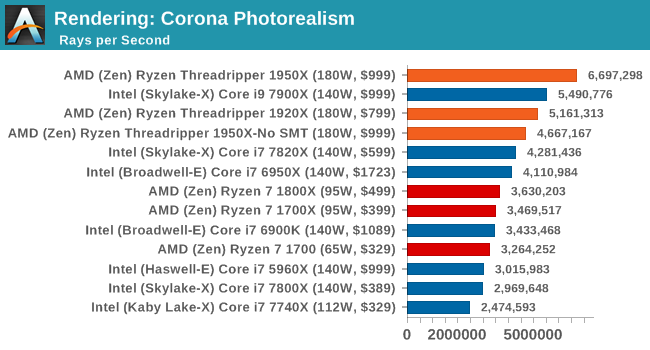
Corona loves threads.
Blender 2.78: link
For a render that has been around for what seems like ages, Blender is still a highly popular tool. We managed to wrap up a standard workload into the February 5 nightly build of Blender and measure the time it takes to render the first frame of the scene. Being one of the bigger open source tools out there, it means both AMD and Intel work actively to help improve the codebase, for better or for worse on their own/each other's microarchitecture.
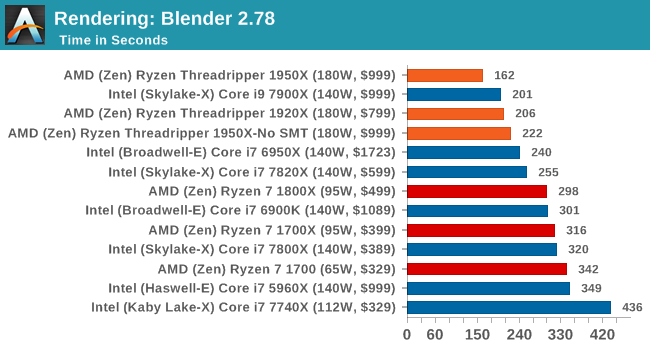
Blender loves threads and memory bandwidth.
LuxMark v3.1: Link
As a synthetic, LuxMark might come across as somewhat arbitrary as a renderer, given that it's mainly used to test GPUs, but it does offer both an OpenCL and a standard C++ mode. In this instance, aside from seeing the comparison in each coding mode for cores and IPC, we also get to see the difference in performance moving from a C++ based code-stack to an OpenCL one with a CPU as the main host.
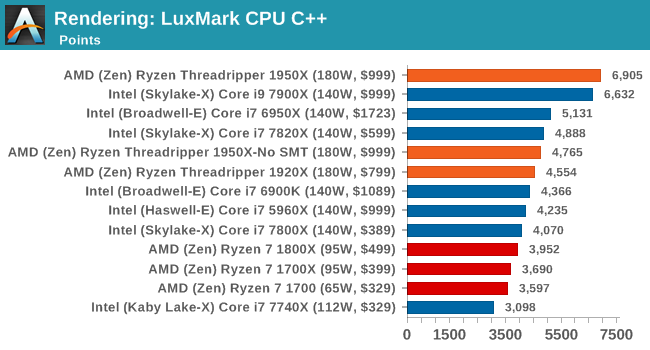
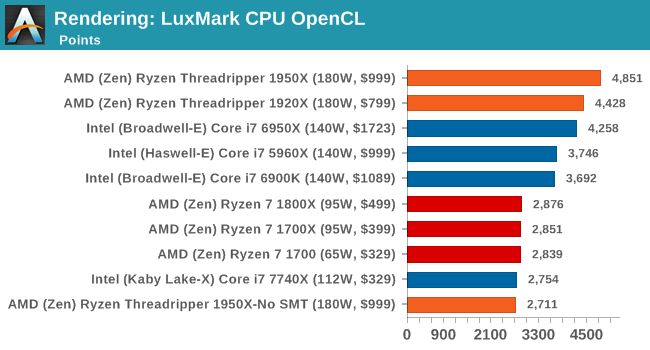
Like Blender, LuxMark is all about the thread count. Ray tracing is very nearly a textbook case for easy multi-threaded scaling. Though it's interesting just how close the 10-core Core i9-7900X gets in the CPU (C++) test despite a significant core count disadvantage, likely due to a combination of higher IPC and clockspeeds.
POV-Ray 3.7.1b4: link
Another regular benchmark in most suites, POV-Ray is another ray-tracer but has been around for many years. It just so happens that during the run up to AMD's Ryzen launch, the code base started to get active again with developers making changes to the code and pushing out updates. Our version and benchmarking started just before that was happening, but given time we will see where the POV-Ray code ends up and adjust in due course.
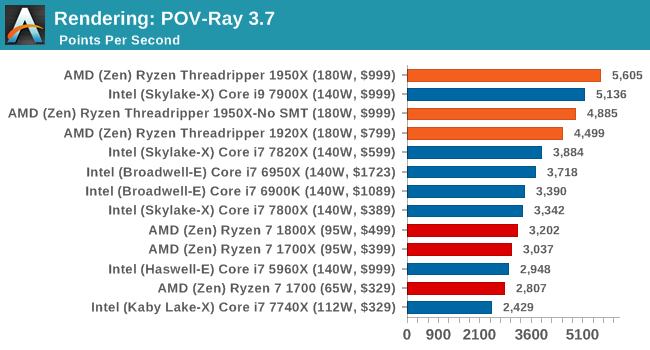
Similar to LuxMark, POV-Ray also wins on account of threads.
Cinebench R15: link
The latest version of CineBench has also become one of those 'used everywhere' benchmarks, particularly as an indicator of single thread performance. High IPC and high frequency gives performance in ST, whereas having good scaling and many cores is where the MT test wins out.
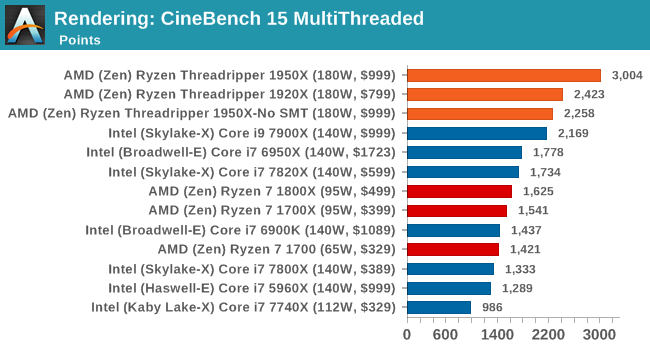
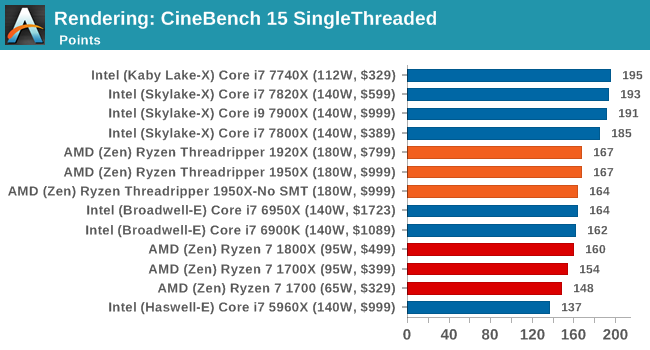
Intel recently announced that its new 18-core chip scores 3200 on Cinebench R15. That would be an extra 6.7% performance over the Threadripper 1950X for 2x the cost.










347 Comments
View All Comments
ddriver - Thursday, August 10, 2017 - link
Yeah if all you do all day is compile chromium with visual studio... Take that result with a big spoon of salt.Samus - Thursday, August 10, 2017 - link
This thing can also decompress my HD pr0n RARs in record time!carewolf - Thursday, August 10, 2017 - link
The jokes is on you. More cores and more memory bandwidth is always faster for compiling. Anandtech must have butched the benchmark here. Other sites show ThreadRipper whipping i9 ass as expected.bongey - Thursday, August 10, 2017 - link
They did without a doubt screw up the compile test. The 6950x is a 10 core /20 thread intel cpu, but somehow the 7900x has 20% improvement, when no other test even comes close to that much of an improvement. The 7900x is basically just bump in clock speed for a 6950x.Ian Cutress - Thursday, August 10, 2017 - link
'The 7900X is basically just bump in clock speed for a 6950X'L2 cache up to 1MB, L3 cache is a victim cache, mesh interconnect rather than rings.
mlambert890 - Saturday, August 12, 2017 - link
It's basically as far from 'just a bump in clock speed' as any follow up release short of a full architecture revamp, but yeah ok.rtho782 - Thursday, August 10, 2017 - link
The whole game mode/creator mode, UMA/NUMA, etc seems a mess. Games not working with more than 20 threads is a joke although not AMDs fault....mapesdhs - Thursday, August 10, 2017 - link
Why is it a mess if peope choose to buy into this level of tech? It's bring formerly Enterprise-level tech to the masses, the very nature of how this stuff works makes it clear there are tradeoffs in design. AMD is forced to start off by dealing with a sw market that for years has focused on the prevalence of moderately low core count Intel CPUs with strong(er) IPC. Offering a simple hw choice to tailor the performance slant is a nice idea. I mean, what's your problem here? Do you not understand UMA vs. NUMA? If not, probably shouldn't be buying this level of tech. :DprisonerX - Thursday, August 10, 2017 - link
That will change. Why invest masses of expensive brainpower in aggressively multithreading your game or app when no-one has the hardware to use it? No they do.Hurr Durr - Friday, August 11, 2017 - link
Only in lala-land will HEDT processors occupy any meaningful part of the gaming market. We`re bound by consoles, and that is here to stay for years.